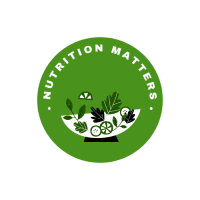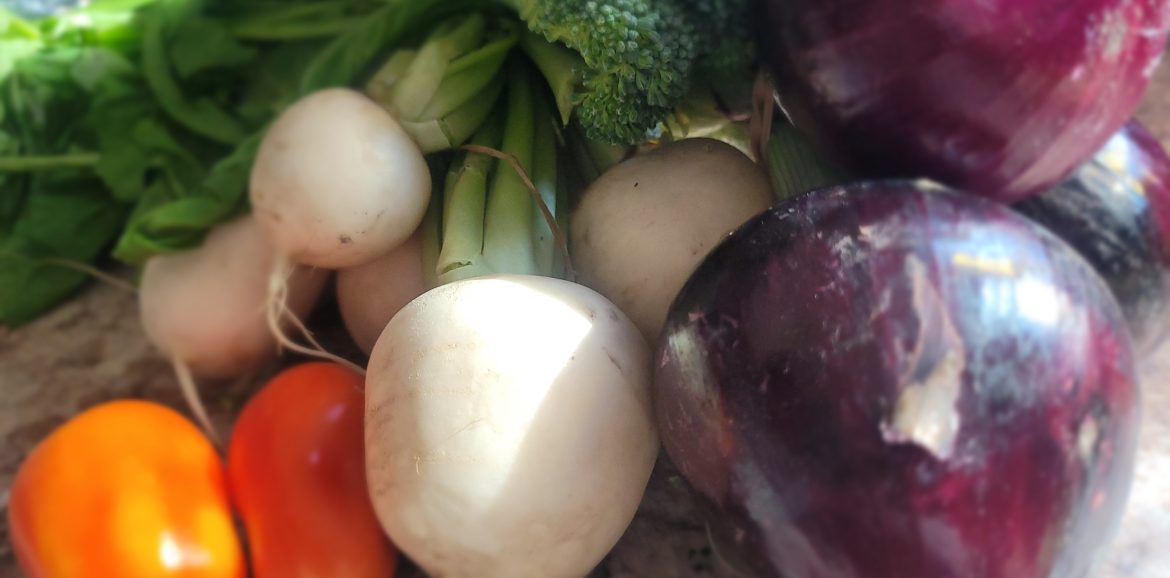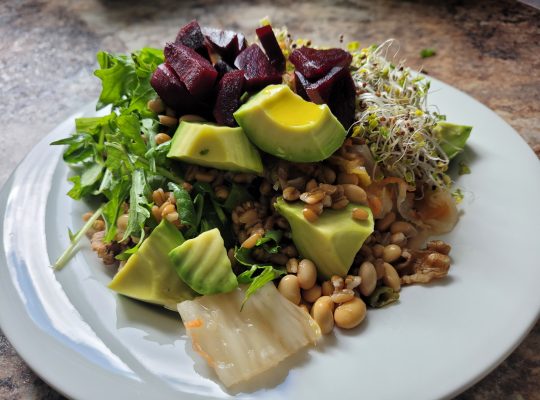The most important take-home message before we get started: do not stop eating fresh fruit and veggies! There are ways to reduce exposure and mitigate risks, but avoidance may increase the risk for gut microbiome imbalances as well as vitamin and mineral deficiencies and decrease joy (significantly!).
Many birds of a (chemical) feather
The pesticides category includes insecticides, fungicides, rodenticides, garden and household chemicals, and also chemicals that are used to treat wood* for example. *A quick note on this latter type: if you collect pallets for any garden or home projects, which many people do, always check to make sure they are heat-treated rather than chemically-treated.
Most pesticides are applied directly in the produce, whether fruit or veggies, and they concentrate in the peel, hence peeling may be useful. However, the peel is where we find active health-promoting compounds such as polyphenols, vitamins, minerals, and fibre too, so ideally, we should eat it rather than throw it away.
For example:
- A whole potato includes the skin, and that means vitamins, minerals, fibre (soluble and insoluble) and polyphenols. Potato skins have become a bit of a trend lately and that’s great, with one caveat: they ought to be organic or else you end up ingesting chemicals. To reduce the glycemic index of potatoes, make sure to cool them completely before you eat them. In doing so, you increase the amount of resistant starch, which is food for some of our friendly gut bacteria.
- A whole apple is …well, delicious, and one of the most nutrient-rich and economical fruit. It contains lots of polyphenols (quercetin, for example), a good amount of fibre, including pectin, and many vitamins. The peel, however, can be loaded with harmful chemicals and sometimes they can go deeper than the peel. Buy organic when possible.
Make your kitchen a friendly chemical-removal lab
Now onto the fun part.
First, some good news: some of the pesticides on conventionally-grown will be washed away or disintegrated due to sun exposure and rain.
The ones that are more persistent and we’re concerned with because they are found on skin or peel (or deeper,) can also be eliminated albeit not entirely.
- Peeling – considered one of the most efficient ways of removing pesticides. Useful if you buy any peelable produce from the ‘dirty dozen’ list (peaches and nectarines, apples, pears, and potatoes, for example). Wash well under cold running water and then peel before consuming.
- Washing under running water (rather than dunking or soaking). Scrub firmly when the peel is firm enough (melons of all kinds), otherwise wash well and then pat dry (tomatoes for example, also on the infamous dirty list).
- Washing in 10 percent salt solution or baking soda solution (10 grams of salt or baking soda per 100mL of water and mix until fully dissolved). This proved to be more effective than washing alone, or washing in vinegar solution, or bleach solution. Soak for at least 12 to 15 minutes, but 20 is better if you have the time. Rinse and pat dry.
- Cooking (blanching, roasting, boiling, etc). If you like roasted peppers, you’re in luck. Roasting them removes over 90 percent of the pesticide residue. Ditto for blanching veggies and/or cooking them fully. For leafy veggies such as cabbage, washing and then stir-frying, were fund to be most effective.
Overall winner: 10 % baking soda solution.
Next best, in this order: 8% vinegar solution, 10% salt solution, plain running water.
Re: Glyphosate
This needs to be addressed separately given that glyphosate (or Roundup) crop treatments have been associated with multiple health risks.
What makes it complicated and quite frankly, evil too, is the fact that crops such as oats, barley, and legumes too, are often sprayed just before harvesting. The practice is less favoured in Canada, so one can hope we will get to see safer practices in the near future. In the meantime, since there is no way of knowing the level of contamination, buy organic when possible and also, eat a variety of legumes instead of just one (such as chickpeas, which is one of the most popular ones).
A word on bacteria
They live on produce and that’s great news when we refer to the non-pathogenic ones that boost our own population of gut bacteria and allow us to ferment veggies. Eating a variety of fruit and vegetables means lots of diverse fibre, soluble, insoluble, and resistant starch, and it also means ingesting …well, bacteria, with each bite.
As for the undesirable or pathogenic ones, which we hear about as being the subject recalls, they can be present on any crop, but mostly on leafy greens (kale, lettuce). While not a frequent occurrence, bacteria contamination is possible. To reduce the risk, buy fresh, crispy leafy vegetables and wash well under cold running water.
Bottom line
Eat your fruit and veggies but wash well beforehand. In case of conventional produce, particularly the ones on the infamous ‘dirty dozen’ list, make a 10 % baking soda solution and soak for 20 minutes. Rinse and pat dry.
The produce you do not need to worry about (aka ‘the clean 15 list’ compiled by the Environmental Working Group or EWG): avocado, sweet corn, pineapple, onions, papaya, sweet peas, asparagus, kiwi, honeydew melon, cabbage, mushroom, cantaloupe, mangoes, watermelon, and sweet potatoes.
(Stay tuned for the next installment on animal foods and chemicals.)






